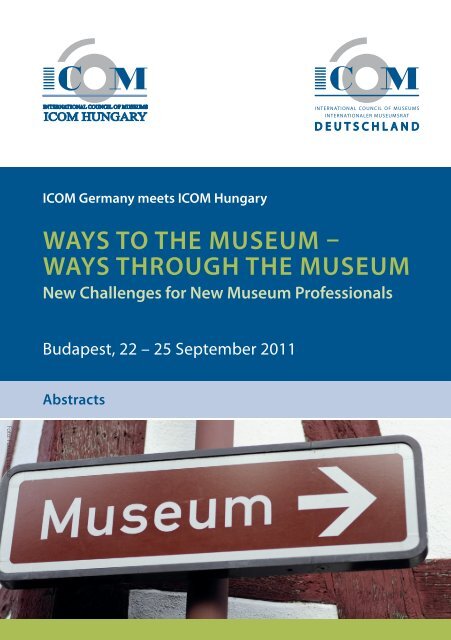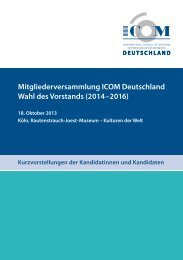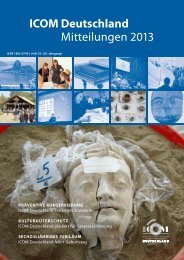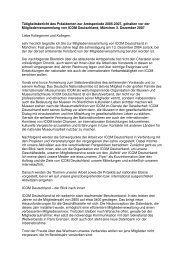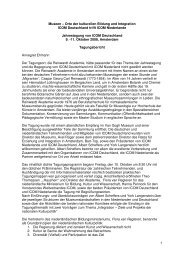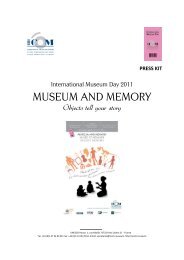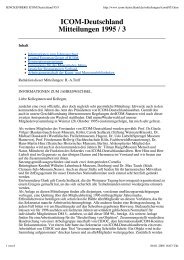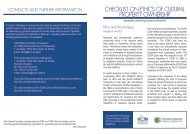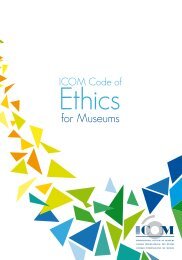Untitled - ICOM Deutschland
Untitled - ICOM Deutschland
Untitled - ICOM Deutschland
Create successful ePaper yourself
Turn your PDF publications into a flip-book with our unique Google optimized e-Paper software.
Contents<br />
MUSEUMS AND MEMORY<br />
Detlef Hoffmann<br />
The End of the Educated Middle Classes and the German Museum . . . . . . . . . . . . . . . . . .3<br />
László Csorba<br />
The Historical Memories of National Conflicts in the Museums of New Europe . . . . . . .4<br />
Gábor Ébli<br />
Museums and Contemporary Art in Eastern Europe in the New Millennium . . . . . . . . . .4<br />
MUSEUMS AND TRAINING OF PROFESSIONALS<br />
Angelika Ruge<br />
Education and Training of Museum Professionals in Germany:<br />
Achievements, Risks and Hopes. . . . . . . . . . . . . . . . . . . . . . . . . . . . . . . . . . . . . . . . . . . . . . . . . . . . . . . .5<br />
Diana Balázs-Szécsi<br />
Encouraging Collections Mobility by Training of Museum Professionals . . . . . . . . . . . . . .6<br />
Franz Jungbluth<br />
‚Wissenschaftliches Volontariat‘ in Germany. Idea(l) and Reality . . . . . . . . . . . . . . . . . . . . . .7<br />
Tamás Vásárhelyi<br />
Formal, Informal and Non-formal Education and Training for<br />
Museum Professionals in Hungary – How to Manage the Sudden Wealth? . . . . . . . . . . .8<br />
NEW COMPETENCES FOR MUSEUMS<br />
Miklós Cseri<br />
A National Museum as a Competence Center . . . . . . . . . . . . . . . . . . . . . . . . . . . . . . . . . . . . . . . . . .9<br />
Stéphanie Wintzerith<br />
Where to find the Expert – New Competences for Today’s Museum . . . . . . . . . . . . . . . . . 10
Gergely Sallay<br />
Militaria – A Special Field of Interest with a Special Audience.<br />
Commitments and Possibilities in the Hungarian Military History Museum . . . . . . . . 12<br />
Katrin Hieke<br />
Challenging Conventions: Freelance Museum Professionals and Agencies . . . . . . . . . 13<br />
Magdolna Vicze<br />
Local Level Networking – A Case Study of Százhalombatta Archaeological Park . . . 14<br />
Edit Bárd<br />
Cooperation and Networking – A Great Opportunity to Improve Skills Together . . . 15<br />
MUSEUM VOLUNTEERING<br />
Gabriella Gulyás<br />
Museum Volunteering in Hungary . . . . . . . . . . . . . . . . . . . . . . . . . . . . . . . . . . . . . . . . . . . . . . . . . . . 15<br />
Udo Liebelt<br />
Museum Volunteering in Germany. Concepts, Management, Training . . . . . . . . . . . . . . 16
MUSEUMS AND MEMORY<br />
Detlef Hoffmann<br />
The End of the Educated Middle Classes and the German<br />
Museum<br />
The traditional museum of the 19th and the beginning 20th century could rely on the well<br />
educated middle class (“Bildungsbürgertum”). Among those people a canon of knowledge,<br />
that included not only the humanities but also basics in science, was taken for granted. We<br />
find this canon in the illustrated press of this time, in Germany the “Leipziger Illustrierte<br />
Zeitung” which was first published in 1843. Museum exhibition curators could depend on this<br />
knowledge. If there were still problems in understanding the objects this public was accu s-<br />
tomed to researching them in a catalogue.<br />
With the dissolution of these classes and the political aim to make the museum accessible<br />
to everyone (“Kultur für Alle”) a presumption of knowledge is no longer realistic. Two concepts<br />
seem to answer the need to bring the widest public into the museums: 1st: Exhi bitions<br />
where people learn what they didn‘t know yet (“Lernausstellungen”). 2nd: The event – people<br />
go to the museum because it is a social necessity.<br />
During the last 20 to 30 years influence on the museums by the political powers has<br />
become stronger and stronger. Exhibitions criticising the status quo are risky for the organisers<br />
– providing they are not private enterprises (ie: the “Wehrmachtsausstellung”) or are<br />
insti gated by the political souvereign, as the exhibition on Enlightenment in China was.<br />
Dr. Detlef Hoffmann: Retired Professor of Art History at the Carl von Ossietzky University.<br />
Study of Art History, Archeology and Christian Archeology in Hamburg, West-Berlin, Munich,<br />
Frankfurt/Main and Freiburg/Breisgau. Thesis on Alfred Rethel’s fresco of Charlemagne (1968).<br />
Studies on the cultural history of playing cards (1968–1971). Curator at the Historisches<br />
Museum Frankfurt (1971–1981). Scientific adviser at the Playing Card Museum in Leinfelden-<br />
Echterdingen (1973–1995). Sabbatical leave for a full-time fellowship at the Kultur wissenschaftliches<br />
Institut Essen (1991–1994) and at the Zentrum für Interdisziplinäre Forschung<br />
Bielefeld (1994–1995). Research on “Vergegenständlichte Erinnerung”, memorials in former<br />
concentration camps (1991–1992). Project “Civil Society and Social Change in Auschwitz”<br />
lead by Jonathan Webber (1992–1995). Project “Legacy of Absence”, a research on traces of<br />
trau matic events in art of the 20th century (1995).<br />
Publications on art and cultural history from the 18th to the 20th century, especially on the<br />
history of photography, playing cards, comics, industrial archeology and on the theory and<br />
practice of museum studies.<br />
3
László Csorba<br />
The Historical Memories of National Conflicts<br />
in the Museums of New Europe<br />
The national traditions of the 27 countries of the European Community have double characters:<br />
One of them comes from the memory of one-time historical conflicts of the partners<br />
nowa days co-operating better and better – meanwhile the other one originated from the<br />
memory of co-operation or are connected to its earlier stages. Both of them preserved<br />
officialy by the museums will play a greater role in the ceremonies of the co-operation of the<br />
Community. The most actual task of our museums is to create a new-kind of “European<br />
history” that tries not to equate but to integrate and show in a larger context the historically<br />
adversative elements of national traditions in a higher-level consensual synthesis. What are<br />
our problems and possibilities working on this field? – what are the main ideas and the most<br />
dangerous contradictions? – these are the topics of my lecture.<br />
László Csorba, PhD: Eötvös Loránd Tudományegyetem, Budapest (1979); CSc/PhD (1989).<br />
Research Fellow, Institute of Philosophy of the Hungarian Academy of Sciences, Budapest<br />
(1979–1990); Associate Professor of Cultural History, Eötvös University, Budapest (since 1990);<br />
Visiting Professor of Hungarian Chair, Indiana University, Bloomington (1992–1993); Scientific<br />
Director of Hungarian Academy of Rome (1998–2003); Director, Hungarian Academy of Rome<br />
(2003–2007); Vicedirector, Institute of History of the Hungarian Academy of Sciences, Budapest<br />
(2007–2010); General Director, Hungarian National Museum, Budapest (since 2010).<br />
Main fields of interest: Cultural and modern Hungarian history, ecclesiastical history of<br />
Hungary, Italian-Hungarian historical relations and connnections.<br />
Publications: 14 books and more than 100 other articles publishing in six languages on the<br />
above mention topics.<br />
Gábor Ébli<br />
Museums and Contemporary Art in Eastern Europe<br />
in the New Millennium<br />
For almost a quarter-century, museums of contemporary art in Eastern Europe have been<br />
suffering from the lost financial background of Communism even though their work is today<br />
largely free of ideological constrains. Art enjoyment appears a pastime of the privileged few;<br />
contemporary art, with its critical-discursive focus, receives little attention from the media. Yet<br />
at closer look, the various museum models in this region, being far from homogenous and<br />
hopeless, reveal the potential for a lively contemporary scene.<br />
This lecture examines a number of new museums such as the Muzej Suvremene Umjetnosti<br />
in Zagreb (priding on its vast building) and the Ludwig Museum in Budapest (located in the<br />
4
prestigious but secluded Palace of Arts), as well as conversions of historical or industrial<br />
monuments into contemporary art museums, e. g. in Ljubljana and Prague. The presentation<br />
addresses issues of government funding (for instance, the famous Znaki czasu programme in<br />
Poland) as much as the growing influence of private capital (Danubiana Art Museum near<br />
Bratislava) and the difficult situation of museums sustained by local governments (City Gallery<br />
in Sofia).<br />
Finally, by comparing the strategies of collecting adopted recently by the museums of<br />
these countries, the assessment lies at hand that many of the institutions have become each<br />
other’s rivals on the barely budding market of East European art from the neo-avantgarde of<br />
the 1960s till today.<br />
Gábor Ébli, PhD: He holds a PhD in Aesthetics and teaches at the Institute for Theoretical<br />
Studies at Moholy-Nagy University of Arts and Design, Budapest. His publications analyse<br />
international issues of museology and private collecting, often with an empirical focus on<br />
Eastern Europe, particularly Hungary.<br />
MUSEUMS AND TRAINING OF PROFESSIONALS<br />
Angelika Ruge<br />
Education and Training of Museum Professionals in Germany:<br />
Achievements, Risks and Hopes<br />
Since the 1970th the museum world in Germany has changed. Museums became an important<br />
part of the cultural sector of the German society. The political slogan of the 1970th<br />
“culture for everybody” has today its echo in the slogan “museum for everybody”. The number<br />
of museums has grown. Even the smallest town is proud to host a museum. Architects<br />
and politicians have the greatest publicity by building and opening a new museum. The<br />
demands of the politicians, the public, and the finance departments are growing. The focus<br />
of my presentation will be the question, if the museum professionals are prepared for these<br />
demands?<br />
Until the unification of Germany 1990, there existed two different training systems for the<br />
museum professionals. In West-Germany the museum curator had to pass a university study<br />
program followed by a two years trainee program in a museum. In East-Germany two models<br />
existed: the university study program with special courses in museology and a study program<br />
for museologist at the technical school in Leipzig. The training of museologists in Leipzig was<br />
of high standard and aimed for professional work in museums of middle and small size.<br />
5
A new museum studies program was installed at the University of Applied Sciences in<br />
Berlin in 1993. At the same time the study program in Leipzig continued.<br />
A research done by Dr. Schuck-Wersig, Berlin, in 2005 identified 26 study programs at<br />
German universities which have included in their curricula subjects of relevance for the<br />
museum work. This is the result of the European University Reform (resolution of Bologna)<br />
with the introduction of Bachelor and Master as a professional relevant degree. I shall focus on<br />
the study programs in Berlin and Leipzig which are the only which organised their studies on<br />
the base the definition of the museum by <strong>ICOM</strong>: a museum is a non-profit organisation which<br />
collects, preserves, exhibits, educates and does research. We shall see if these tasks are still<br />
relevant under the “Code of ethics”, the new guideline for museums. And we shall discuss, if<br />
under the growing diversity of requirements in the museum work, a basic understanding of<br />
what is a museum, should be the basement of all museum work. Will lifelong training will<br />
become the new way to the professionalisation of museum work?<br />
Dr. Angelika Ruge: She taught at the University of Applied Science Berlin (HTW Berlin) and<br />
was the organizer of the museum Studies Program (1993–1994). Until her retirement she was<br />
the head of department and since 1994 member of ICTOP (International Committee for the<br />
Training of Personnel in <strong>ICOM</strong>), member of the board (1998) and president of the committee<br />
(2004–2010).<br />
A historian by training, she was doing research on contemporary European and German<br />
history. She got ther PhD from Technische Hochschule Darmstadt. She lectured in Darmstadt<br />
and Southampton. After doing research in cultural history during her stay at the Center for<br />
European Studies at Harvard University, Cambridge Ma, she became curator for historical<br />
exhibitions in the city of Bonn. She joined the staff of the Haus der Geschichte (Museum for<br />
Contemporary History of the Federal Republic of Germany) in Bonn, where she became the<br />
head of the department for exhibitions. She was responsible for the first exhibition of the<br />
museum on contemporary German history from 1945 to 1989.<br />
She has published several articles about contemporary German history, cultural history<br />
and the museum studies program in Berlin. She edited “Museum Professions – A European<br />
Frame of Reference” (a joint project of ICTOP and <strong>ICOM</strong> France, Italy and Switzerland, 2008).<br />
Her interests in the museum field are the history of museums and collections, museum<br />
management, museum education, evaluation and exhibition planning.<br />
Diana Balázs-Szécsi<br />
Encouraging Collections Mobility by Training<br />
of Museum Professionals<br />
In 2009, nine cultural institutions from eight EU member states set up the project Collections<br />
Mobility 2.0 Lending for Europe 21st century, with the aim of introducing the most recent<br />
6
concepts, standards and procedures on lending and borrowing of museum collections into<br />
the everyday museum practice. The importance of this topic has been pointed out on several<br />
cultural conferences during the last years as well as in the frame of an EU working group<br />
dedicated to the dismantling of the (legal and administrative) obstacles for the exchange of<br />
cultural moveable heritage. The museum professionals – in most of the cases registrars and<br />
collection keepers – face problems and tasks related to insurance of works of art, state indemnity,<br />
immunity from seizure, loan agreements and long-term loans day-by-day, however<br />
they could not so far benefit from specialised trainings on this field. Therefore, in the frame of<br />
the project three workshops have been organised on a ’train the trainer’ principle in three<br />
countries holding the EU presidency in 2010 and 2011 focusing on the abovementioned<br />
topics of collections mobility. These courses, given by highly qualified experts, were open to<br />
delegates from all EU member states who undertook to further cascade the training programme<br />
in their own countries. For the sake of sustainability a website and a handbook have<br />
been published to reinforce the effect of the training sessions. The Artnewspaper in its<br />
February issue also heralded the success of the project, as a result of which networks of<br />
museum professionals and cultural institutions have been created facilitating the cooperation<br />
in the field of lending and borrowing of works of art.<br />
Diána Balázs-Szécsi: She is a lawyer working at the Legal and Registrar’s Department of the<br />
Museum of Fine Arts, Budapest. She has a degree in general law from the University of<br />
Szeged as well as in European Union law from the University of Lyon III. She has been working<br />
for the EU’s OMC working group on the Mobility of Collections, in the state indemnity/<br />
insurance/shared liability sub-group, and she is now member of the current OMC group,<br />
taking part in the sub-group dealing with risk assessment. She was member of the Collections<br />
Mobility 2.0 project as one the main organisers of the collections mobility training.<br />
Franz Jungbluth<br />
‚Wissenschaftliches Volontariat‘ in Germany. Idea(l) and Reality<br />
The uniqueness of the German “Volontariat” does not only show when searching for an<br />
appropriate translation of this term. Even in the neighbouring German speaking countries,<br />
the concept of a traineeship for academic museum staff is hardly known. The same is true for<br />
both the development of codified curricula for this programme from the 1990s onwards and<br />
for the current boom in Volontariat jobs on the academic labour market.<br />
This boom, however, is at best an ambivalent one. First of all, the increase in Volontariat<br />
jobs is accompanied by a decreasing level of academic jobs on the intermediate level. Second,<br />
the reality of specialised “Volontariate” for PR, education, exhibition design etc. contradicts the<br />
ideal of the broad museum curriculum codified over the last 20 years. These developments<br />
raise the question if the “Volontariat” still meets the needs of both museums and young<br />
7
professionals – or if they would be better off with specialised trainee programmes that reflect<br />
the overall development of professionalization and specialisation within the different spheres<br />
of museum work as it is today.<br />
Franz Jungbluth: He holds a Magister Artium in Social and Economic History and Political<br />
Sciences. He was awarded a full three-year graduate scholarship by the Friedrich-Ebert-<br />
Foundation to pursue his doctoral studies (2006-2009). Besides his studies he has participated<br />
in different academic and commercial projects in Labour History and Business History.<br />
He has been working as “Wissenschaftlicher Volontär” at TECHNOSEUM Mannheim (since<br />
2009). This “Volontariat” follows a “classical” curriculum including public relations (events and<br />
marketing) and organisation of exhibitions (special exhibit on the German labour movement).<br />
Tamás Vásárhelyi<br />
Formal, Informal and Non-formal Education and Training for<br />
Museum Professionals in Hungary – How to Manage the Sudden<br />
Wealth?<br />
A continuous choice of formal learning opportunities in museology (in the broad sense),<br />
accompanied with certain academic branches like history, art history, ethnography, and a few<br />
professional training opportunities were offered for museum workers in the last decades in<br />
Hungary. Non-formal museum management courses were offered with Dutch initiative,<br />
co-operation and support (from 1992) as well as a few other training opportunities by civil<br />
organisations, museums and the inspectorates. A new law (2000) ordered vocational training<br />
of most museum employees (120 hours in seven years). While a rich and diverse offer of<br />
accredited courses were soon developed e. g. for the community culture and library fields,<br />
museums failed to develop the necessary trainings or courses (moreover, some influential<br />
leaders openly neglected the aim and value of such education).<br />
A change came with establishing MOKK (in English ETCM, the Education and Training<br />
Center for Museums) which developed a series of publications and a series of training courses.<br />
A few museums developed also their own accredited courses.<br />
What are the topics of these courses? Do these match the most urgent needs of museums?<br />
Which areas are lacking? Have the common notion of trainings changed, and do museum<br />
employees use the opportunity given to them? These are questions to be answered not only<br />
by the presentation, but by the museum society of Hungary.<br />
Tamás Vásárhelyi, PhD: Curator of the Rhynchota collection (1978); Deputy director of the<br />
Zoological Department (1984); Deputy director general of the Hungarian Natural History<br />
Museum (education, exhibitions and marketing, 1991); Senior concillor, head of Education<br />
8
and Trainings (2009). Active in formal, non-formal and informal education at two university<br />
faculties, within ETCM, in HSEE and HNHM.<br />
Studies: Research biologist (1973), CSc (PhD) thesis in entomology (1983), later trainings<br />
on managing skills. Collecting and study trips in several European and Asian countries and<br />
twice in US museums.<br />
Publications: About 250 scientific or popular papers (15 books) on entomology, nature<br />
protection, environmental education, museums, museum education, management.<br />
NEW COMPETENCES FOR MUSEUMS<br />
Miklós Cseri<br />
A National Museum as a Competence Center<br />
In 2007, Hungarian Government brought a decision, accordingly – from logistic point of<br />
view – they would outsource certain tasks of great national museums into a firm established<br />
by the cultural government. This was a shock for national museums, as they saw their European<br />
level outstanding independence to be diminished. So, several museums tried to<br />
transform or modify their operational profile according to the new trend, and reposition<br />
theirselves.<br />
The solution has been determined by the process of undertaking competence roles, resp.<br />
operating the museum as a competence center. This could be realized by taking over national-level<br />
tasks. Hungarian Open Air Museum had a leading role in this process, and executed<br />
four new national tasks between 2008 and 2011, which could be, however, organically adjusted<br />
to the original mission statement. MOKK (including education of museum sphere), SZKÖI<br />
(protection of cultural heritage), Association of Country Houses (protection of folk heritages)<br />
and the rural development project (protection and revival of rural values for the sustainable<br />
development) have been established.<br />
Accordingly, Hungarian Open Air Museum has maintained its high social prestige and<br />
embeddedness as national museum – on the one hand, and has broadened its social base,<br />
reinforced its networking, positioned itself in the palette of cultural institutions – on the other<br />
hand. Their example was followed by a number of Hungarian national collections during the<br />
past years.<br />
Miklós Cseri, PhD: Acting director Hungarian Open Air Museum, Szentendre (1994–1995).<br />
Deputy director, Hungarian Open Air Museum, Szentendre (1993–1994). Scientific secretary,<br />
Hungarian Open Air Museum Szentendre (1989–1994). Researcher, Hungarian Open Air<br />
9
Mus eum, Szentendre (1987), Ethnographer researcher, Herman Ottó Museum, Miskolc<br />
(1981–1987). Director, Hungarian Open Air Museum, Szentendre (since 1996).<br />
Academic qualifications: PhD, Ethnography, Kossuth Lajos University, Debrecen (1995). MA,<br />
Ethnography, Kossuth Lajos University, Debrecen, (1984). BA, Ethnography and History, Kossuth<br />
Lajos University, Debrecen, Faculty of Arts (1982).<br />
Publications: Three books, 45 collection of articles reducted 87 scientific articles.<br />
Membership of Professional Organizations: <strong>ICOM</strong> Hungary (1993), Vice-president (1996),<br />
President (2002–2008, since 2011). European Open Air Museums‘ Association (1991), Member<br />
of the board (1997), President (2003–2007). Pulszky Society – Hungarian Museums‘<br />
Association, Vice-president (1996). National Museums’ Association, Board member (2005–<br />
2009), President (2010).<br />
Main fields of interest: Vernacular architecture, earthen architecture, way of living, protection<br />
of earthen and other traditional buildings, museum marketing, museum managing,<br />
fund-raising, cultural heritage and tourism, museums and tourism, museums and public<br />
orga nizations (foundations, associations), independence-autonomy of the museums.<br />
University education activity: Cultural heritage and tourism at the Kodolányi-College,<br />
Székes fehérvár. Open air museology at the University of Debrecen, Open air museology at<br />
Pécs University, Open air museology at Budapest University. History of pitty nobles in Hungary,<br />
Pécs University; Honorary professor of Pécs University (since 2010).<br />
Stéphanie Wintzerith<br />
Where to find the Expert – New Competences<br />
for Today’s Museum<br />
“Là où il reste de la poussière, c’est que le balais ne passe pas”. Where there remains dust,<br />
it’s because the broom didn’t sweep there. Let one of Michel van Praët’s favourite sentences<br />
introduce the core topic of this contribution: change in the museum. Most museums are<br />
not as dusty and old fashioned as they are thought to be: they swept the dust away, let in<br />
a wind of change and took up fresh ideas. Their broom is a bunch of new methods, their<br />
energy the courage to experiment new ways of doing and explore new paths. Neither did<br />
they do it all at the same time, nor all by themselves. They often had expert help from the<br />
outside.<br />
Management tools, visitor research, communication and information technologies, event<br />
management, interactive exhibits, cultural diversity, sustainability, to name but a few new or<br />
fast evolving examples, have made their entry in the museum landscape in the last decades,<br />
with long lasting effects. It’s not fashion that is at stake but the role of museums in their<br />
society, their ability to reach audiences with interesting and up-to-date methods/means,<br />
their capacity to adapt to changing expectations, or even to initiate them. It sometimes is<br />
even a question of survival.<br />
10
Those and many other topics brought/bring changes and require/d new expertise. Who’s<br />
the expert, then? It’s a well trained (creative) person with experience in this particular field.<br />
Where can one find him/her? The main question remains: inside or outside? Integrate these<br />
new competencies into the staff or rely on outsourcing? The answer to that question is<br />
depend ing on many factors, the most important being the economic (do we have the<br />
budget?) and strategic (is it a core function for our museum?) ones as well as the time frame<br />
(is it an occasional action or a long-term activity?).<br />
Take visitor research for example. In the last thirty years, a shift has taken place from the<br />
object-centred to the audience-oriented museum. As a consequence, it becomes crucial to<br />
know ones visitors and to have information about their expectations, satisfaction, reception<br />
of the exhibitions etc. Visitor research and evaluation – as well as their extension audience<br />
development – are disciplines that help museums to become really visitor oriented. Academic<br />
research and empirical studies bundled to supply new methods and know-how, a solid basis<br />
for a field of expertise.<br />
A growing number of museums recognise the importance of visitor research and some<br />
lucky few have even dedicated staff, thus extending their own competences. Most museums<br />
however acknowledge that they do not have the required skills or the time to do surveys<br />
themselves according to professional standards. They rely on the competent help of external<br />
experts and commission institutions, research institutes, universities or free-lancers to carry<br />
out the surveys, studies and evaluations they need.<br />
Though a niche segment in the broader range of consultancy for museums, visitor research<br />
and evaluation give young people interested in museums and their audiences a chance to set<br />
a foot in the museum. It is still very hard to make a living out of it. The offer of services nevertheless<br />
tends to grow, especially in the freelance sector. The constraints are huge: uncertainty,<br />
difficulty to plan in middle or long term, (usually) poor pay, alternation of periods without and<br />
with too much work. On the other hand, the content of the work is very rewarding and never<br />
dull, there is a large diversity of research and/or exhibition topics and mainly enthusiastic<br />
partners to work with. It needs a good sense of organisation, resistance to stress, a faculty to<br />
adapt to new situations and new partners, an analytical mind and a very thorough and<br />
thought ful handling with statistics. And it needs experience, of course.<br />
Like visitor research, every museum has a certain number of fields where it needs support.<br />
Because you can’t be an expert in everything, can you?<br />
Dr. Stéphanie Wintzerith: She is carrying out evaluations and visitor studies for museums<br />
and other cultural institutions. She graduated at the European School of Management (Paris-<br />
Oxford-Berlin) and holds a master in Ethnology (France). Her PhD topic covered the international<br />
cooperation of museums and its intercultural dimension. After completing her<br />
doctorate (2006), she took over the Centre of Evaluation and Visitor Research at the Badisches<br />
Landesmuseum in Karlsruhe for two years as its scientific director. She is working free lance<br />
(since 2008) with a strong focus on international project and is member of the board of <strong>ICOM</strong><br />
Germany.<br />
11
Gergely Sallay<br />
Militaria – A Special Field of Interest with a Special Audience.<br />
Commitments and Possibilities in the Hungarian Military History<br />
Museum<br />
The Hungarian Military History Museum is special in many ways. It is maintained by the<br />
Ministry of Defence, but is professionally supervised by the Ministry of National Resources. It<br />
is one of the country’s national museums, but it is only a part of a complex institution, namely<br />
the Military History Institute and Museum, which is Hungary’s central institution dealing with<br />
military history. (Other parts of the institution include the Military History Archives, the Military<br />
History Library, and other public collections.) The abovementioned facts already imply that<br />
the Museum’s activities include several special tasks. Besides collecting, preserving, researching<br />
and publishing the artefacts and documents of Hungarian and Hungarian-related military<br />
history, the Museum also takes part in the cultural life of the armed forces, and closely<br />
cooperates with the other institutions incorporated by the Military History Institute and<br />
Museum. For example, the Museum organises conferences and publishes books together<br />
with the historians, archivists and librarians working in the same institution, and researchers<br />
too are often “shared”.<br />
The Military History Museum is also special considering its audience. Militaria-collecting<br />
has become a rather popular hobby in Hungary, and militaria enthusiasts come to the<br />
Museum as if they came to a religious place. They come to learn; they come to carry out<br />
research; they come to help and to become involved in the various activities of the Museum.<br />
The Military History Museum is becoming a competence centre for amateur military historians;<br />
for historical re-enactors; for private collectors; for the makers of military-related films, etc.<br />
Since military history is a special science, the Museum has special collections and employs<br />
experts with special skills: experts dealing with weapons, uniforms, insignia, etc. For that<br />
reason, the Museum also acts as a national authority in these fields of competence.<br />
As yet another aspect of the special nature of the Museum, it should be emphasised that<br />
most males in this country had seen military service during the past 150 years, and therefore<br />
most families show some kind of interest for the nation’s military history and many people<br />
also show great respect towards the armed forces. Regardless of their social status, people<br />
tend to become “clients” of the Museum at some stage – either as researchers or as visitors.<br />
Therefore, working in the Military History Museum provides excellent possibilities to get<br />
acquainted with interesting people and exciting stories, and offers the pleasure for the<br />
curators to be able to help those interested in their family past. This personal aspect makes<br />
this job very appealing.<br />
To fulfil all the commitments mentioned above, the curators of the Museum have to be<br />
adaptable; they need a wide range of knowledge concerning both the past and the present<br />
of the military; and in addition to all that, they also have to be familiar with the “civilian” world<br />
of museums. Consequently, the Military History Museum offers great possibilities for young<br />
and adventurous museum professionals.<br />
12
Gergely Sallay, PhD: He is historian and museum curator with translation skills in English.<br />
Hungarian Military History Museum, Head of Documentation Department (since 2009); Hungarian<br />
Military History Museum, Head of Medals Collection (since 2001).<br />
Education: PhD in History, MA in English Literature and Linguistics and Historical Museum<br />
Studies. Debrecen University, Doctoral Department of History and Ethnography (2008–2009);<br />
Eötvös Loránd University Budapest, Department of Historical Museum Studies (1999–2004);<br />
Károli Gáspár University Budapest, Department of English Literature and Linguistics (1996–<br />
2001); Károli Gáspár University Budapest, Department of History (1996–2001); Baár-Madas<br />
Calvinist Secondary School Budapest (1992–1996).<br />
Main fields of interest: History of orders, decorations, medals and badges. Expertise in the<br />
organisation and recording of museum collections.<br />
Katrin Hieke<br />
Challenging Conventions: Freelance Museum Professionals<br />
and Agencies<br />
As outsourcing and externalisation to freelancers, consultants or agencies is getting more<br />
and more common among museums, the field of professions associated with museums<br />
broadens and the traditional concept of a museum career is challenged. In my presentation I<br />
will focus on some recent developments from different perspectives: as a young curator and<br />
scientist, a staff member of an agency working for cultural institutions, and from the standpoint<br />
of an university lecturer engaged with the training of prospective museum professionals.<br />
Outsourcing in its broadest sense comes with a lot of different faces: it may be deliberate<br />
or inevitable, temporary or longtime; it may involve different legal affiliations and funding<br />
and, most important here, it concerns not only “new” professions but also core tasks that until<br />
lately were exclusively restricted to museum professionals in museums. Thus, freelancers,<br />
consultants or agencies now contribute competences in very diverse fields: e.g. scientific<br />
research, marketing, public relations, cultural tourism, graphic and exhibition design and<br />
museum education, enriched with fresh external perspectives due to experiences gained<br />
through the work with and for different museums. Despite these positive aspects, fruitful collaborations<br />
and cooperations with externs are sometimes impaired for different reasons.<br />
The extended and more and more specialized range of modern museum tasks – including<br />
the alternatives of working not in, but still for museums – are rarely reflected or incorporated<br />
in the conventional training of museum professionals. Important to <strong>ICOM</strong> is to note, that<br />
young museum professionals and hence potential members equally committed to the ethical<br />
standards of museum work are not only found within the museums anymore. I suggest that<br />
all these developments are worth to be accounted for in the future work and approach of<br />
<strong>ICOM</strong>.<br />
13
Katrin Hieke: She graduated in 2005 in archaeology, cultural anthropology, pedagogics and<br />
sociology at the Universities of Tübingen/Germany and Bergen/Norway (2005). She completed<br />
traineeship (Wissenschaftliches Volontariat) as a museum consultant and curator of<br />
exhibitions in Germany and Spain at the Rhineland Regional Council (Landschaftsverband<br />
Rheinland). She recieved an advanced certificate in further education from the Institute of<br />
Cultural Management of the University of Education Ludwigsburg/Germany (2007).<br />
Katrin Hieke is a PhD student in museum studies at the University of Tübingen as well as a<br />
university lecturer and staff member of the project2508 Group Bonn/Berlin/Antwerpen/<br />
London, a full service agency for the cultural and tourism sector (since 2008).<br />
Magdolna Vicze<br />
Local Level Networking – A Case Study of Százhalombatta<br />
Archaeological Park<br />
The Archaeological Park at Százhalombatta is a local historical museum with extensive<br />
archaeological and historical records representing the history of the settlement during the<br />
last 4000 years. The Archaeological Park offers a unique opportunity to represent the prehistoric<br />
past of the local area through reconstructions of Bronze and Iron Age houses,<br />
buildings, and a burial mound. The Park is an excellent area for living history, experimental<br />
archaeology and environmental reconstruction.<br />
The 3,5 hectar open air territory of the Archaeological Park has opened new possibilities<br />
and opportunities for museum pedagogy. The Park presents both the natural and the<br />
constructed prehistoric environment of the area. The prehistoric building and tool reconstructions<br />
create exceptional aura and prospects for school children and family activities.<br />
Here we are able to use and combine well attested and customary educational and hands-on<br />
interactivities with first-person interpretations and several new teaching/activity methods for<br />
an unique experience for all ages.<br />
Magdolna Vicze, PhD: She finished her university studies as an archaeologist (1986), studying<br />
prehistoric societies of the Carpathian Basin, submitted her PhD thesis on the same theme<br />
(2000). She is working in the Matrica Museum, Százhalombatta (since 1996). She is director of<br />
the museum and Archaeological Park (since 2005).<br />
14
Edit Bárd<br />
Cooperation and Networking – A Great Opportunity<br />
to Improve Skills Together<br />
How is it possible to update my knowledge in the changing world of museum, in a changing<br />
society? Where can I improve my skills as a young museum professional? In learning<br />
communities I have found the answer – and more: masters and peers, colleagues and friends<br />
coping with similar challenges.<br />
Edit Bárd: Public relations and marketing manager, Danube Museum, Esztergom. Regional<br />
coordinator of the Museum Education and Training Centre in Komárom-Esztergom County.<br />
Member of the Pulszky Társaság – Hungarian Museum Association’s Committee. Lecturer on<br />
museum communication and museum education at different universities and museumcourses.<br />
Education: Art manager, teacher of Hungarian language and literature, teacher of Hungarian<br />
as a foreign language, teacher of drama in education.<br />
Work experiences: Public relations and marketing manager, Hungarian Open Air Museum,<br />
Szentendre (2005–2009); Program organiser, Hungarian Open Air Museum, Szentendre<br />
(2001–2004).<br />
MUSEUM VOLUNTEERING<br />
Gabriella Gulyás<br />
Museum Volunteering in Hungary<br />
The presentation will give a survey of volunteering in Hungary in the past decades with<br />
special regard to the new developments in cultural and museum volunteering. It will explore<br />
the understanding of volunteering including mutual motivations, inherent benefits and difficulties<br />
and will also present some examples of good practices in the field and examine the<br />
Petőfi Literary Museum’s volunteer programme in detail.<br />
Gabriella Gulyás: She is a teacher and teacher trainer by profession. Graduated from Debrecen<br />
University and studied at universities in Budapest, Plymouth and Manchester. Having had 15<br />
years of classroom teaching and school administration experience she joined the British Council<br />
in 1994 where she was in charge of managing the teacher training, literature and cultural<br />
heritage programmes including a number of long term bilateral and European partnership<br />
15
projects. She started to work for the Petőfi Literary Museum (2007) as an advisor and coordinator<br />
of the Revival of Hungarian Literary Memorial Houses programme. Initiated the mus eum’s<br />
volunteer programme (2010). Currently she is Head of Exhibitions and Museum Education.<br />
Udo Liebelt<br />
Museum Volunteering in Germany.<br />
Concepts, Management, Training<br />
In my statement primarily I’m trying to answer to these questions:<br />
Concepts<br />
How German museum officers understand “Museum Volunteering” (M.V.)?<br />
Which traditions and models we have for it?<br />
Which cultural and political aims M.V. is following in Germany?<br />
Which scentific base the discussion on Volunteering resp. M.V. has in our country?<br />
For which advantage we are charging volunteers?<br />
Management<br />
In which activity-fields of (A) professionally leaded and (B) honorary organized museums<br />
volunteers are in charge?<br />
Which forms of management are practized in our museums?<br />
Which elements of structure are belonging to a professional volunteering program?<br />
Training<br />
Why and for which advantage we are training volunteering personal?<br />
Dr. Udo Liebelt: Studies in prot. theology, christian archeology, history of art. Graduated as a<br />
Doctor of Theology in Marburg/Lahn. Professional employments as a gallerist, teacher of art,<br />
primarily as officer at museums of art, i. e. working as Curator of education, communication<br />
and exhibitions, last (1978–1997) at the Sprengel Museum Hannover. Lecturer of universities<br />
within Germany, Brazil, Japan a. o.. Editor resp. author of artbooks, exhibition catalogues, documentations<br />
of conferences in affairs of museum education, last: Vom Geist der Dinge. Das Museum<br />
als Forum für Ethik und Religion (Dresden, 2001).<br />
Honorary activities: Chairman of the German museum educators within <strong>ICOM</strong>/CECA;<br />
Board member of <strong>ICOM</strong> Germany; Founder and head of “Initiative Ehrenamt für das Badische<br />
Landesmuseum Karlsruhe”; Founder and head of “Netzwerk Bürgerschaftliches; Engagement<br />
im Museum” (www.netbem.eu) and editor of netbem.eu Newsletter (2006–2011). After his retirement<br />
he lives and works honorary as museum adviser in Karlsruhe/Germany.<br />
16


